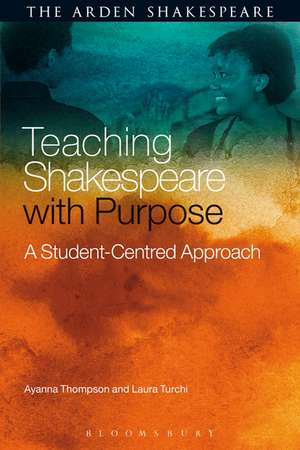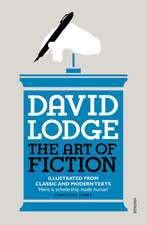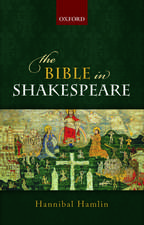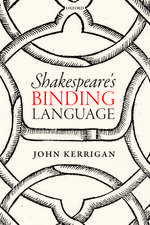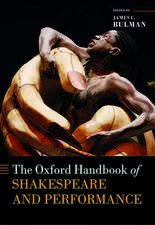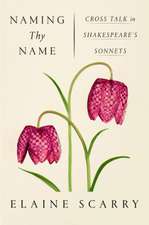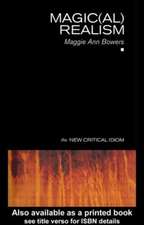Teaching Shakespeare with Purpose: A Student-Centred Approach
Autor Professor Ayanna Thompson, Laura Turchien Limba Engleză Hardback – 27 ian 2016
| Toate formatele și edițiile | Preț | Express |
|---|---|---|
| Paperback (1) | 178.22 lei 3-5 săpt. | +43.01 lei 7-13 zile |
| Bloomsbury Publishing – 27 ian 2016 | 178.22 lei 3-5 săpt. | +43.01 lei 7-13 zile |
| Hardback (1) | 655.58 lei 6-8 săpt. | |
| Bloomsbury Publishing – 27 ian 2016 | 655.58 lei 6-8 săpt. |
Preț: 655.58 lei
Preț vechi: 839.64 lei
-22% Nou
Puncte Express: 983
Preț estimativ în valută:
125.46€ • 130.50$ • 103.58£
125.46€ • 130.50$ • 103.58£
Carte tipărită la comandă
Livrare economică 12-26 aprilie
Preluare comenzi: 021 569.72.76
Specificații
ISBN-13: 9781472599629
ISBN-10: 1472599624
Pagini: 192
Ilustrații: black & white illustrations
Dimensiuni: 156 x 234 x 13 mm
Greutate: 0.45 kg
Editura: Bloomsbury Publishing
Colecția The Arden Shakespeare
Locul publicării:London, United Kingdom
ISBN-10: 1472599624
Pagini: 192
Ilustrații: black & white illustrations
Dimensiuni: 156 x 234 x 13 mm
Greutate: 0.45 kg
Editura: Bloomsbury Publishing
Colecția The Arden Shakespeare
Locul publicării:London, United Kingdom
Caracteristici
Written
by
a
renowned
Shakespeare
scholar
and
an
expert
in
teacher
education,
the
book
blends
the
most
effective
approaches
from
the
humanities
and
the
methodologies
from
the
social
sciences.
Notă biografică
Ayanna
Thompsonis
Professor
of
English,
George
Washington
University,
USALaura
Turchiis
Assistant
Professor
of
Education,
University
of
Houston,
USA
Cuprins
Chapter
One:
Introduction:
The
Realities
of
the
21st
CenturyChapter
Two:
Finding
Your
Purpose
and
Putting
It
into
Action:
FramingChapter
Three:
'Ancient
English':
Shakespeare's
LanguageChapter
Four:
Embodiment:
What
Is
It
(Not)?Chapter
Five:
History:
What
Time
Are
You
Thinking
About?Chapter
Six:
Writing
Assignments
with
a
PurposeChapter
Seven:
Assessment
with
a
PurposeChapter
Eight:
The
Tyranny
of
ResourcesBibliographyIndex
Recenzii
Thompson
and
Turchi
describe
techniques
for
moving
us
away
from
teacher-centered
historical
expertise
toward
a
collaborative
and
participatory
model
of
learning
that
puts
Shakespearean
language
and
performance
at
the
center
of
the
classroom
experience
.
It's
innovative,
practical,
and
generous;
I
hope
it
will
be
read
widely
and
put
to
use.
Teaching Shakespeare with Purposeis not just a practical guide but an argument for the continued relevance of Shakespeare survey courses . Each chapter grounds the teaching theory in practical examples from a model class. The chapters are full of helpful activities including model close readings, themes, and questions from the plays selected (each chapter relies on a different one to model the pedagogy discussed). This approach is advantageous since it provides value for readers who may only have time to read a chapter or two. As well, the pedagogical process described is adaptable to any set of plays. Thompson and Turchi discuss framing, guided questions, entry points, and close readings that allow any teacher the structure she needs to get started on designing her Introduction to Shakespeare course while preserving an individual's pedagogical strengths and the freedom to pick any of the plays . As someone working on an 'Introduction to Shakespeare' class for the first time, this book was a must read if only for the way that it helped put the task of design, teaching, and assessment, in perspective. However, the authors demystify and clarify the purpose of all of the aspects of an introductory course in a way that is not overbearing. Their argument is always student-centered and asks us to make choices about how we approach any aspect of the play (be it the history, the language, or the writing assignments we pick) in order to enhance the experience for the students. In this way, they have given readers a good model not just for the teaching of an 'Introduction to Shakespeare' course but other literature courses as well.
Teaching Shakespeare with Purposeis not just a practical guide but an argument for the continued relevance of Shakespeare survey courses . Each chapter grounds the teaching theory in practical examples from a model class. The chapters are full of helpful activities including model close readings, themes, and questions from the plays selected (each chapter relies on a different one to model the pedagogy discussed). This approach is advantageous since it provides value for readers who may only have time to read a chapter or two. As well, the pedagogical process described is adaptable to any set of plays. Thompson and Turchi discuss framing, guided questions, entry points, and close readings that allow any teacher the structure she needs to get started on designing her Introduction to Shakespeare course while preserving an individual's pedagogical strengths and the freedom to pick any of the plays . As someone working on an 'Introduction to Shakespeare' class for the first time, this book was a must read if only for the way that it helped put the task of design, teaching, and assessment, in perspective. However, the authors demystify and clarify the purpose of all of the aspects of an introductory course in a way that is not overbearing. Their argument is always student-centered and asks us to make choices about how we approach any aspect of the play (be it the history, the language, or the writing assignments we pick) in order to enhance the experience for the students. In this way, they have given readers a good model not just for the teaching of an 'Introduction to Shakespeare' course but other literature courses as well.
